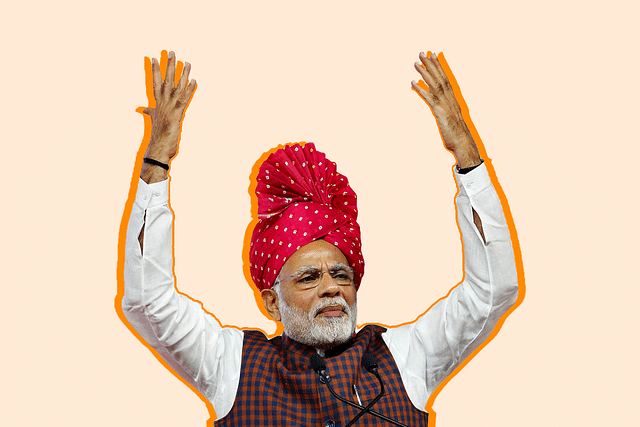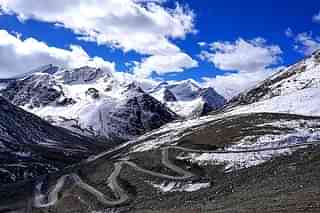Politics
Why '400 Paar' Is Ambitious, Yet Attainable, For The NDA
Venu Gopal Narayanan
May 03, 2024, 06:06 PM | Updated 06:28 PM IST
Save & read from anywhere!
Bookmark stories for easy access on any device or the Swarajya app.

The ongoing 2024 general elections are gripped by one question: will the Bharatiya Janata Party (BJP) and its coalition confreres, the National Democratic Alliance (NDA), cross 400 seats this time? There is even a catchy slogan for this goal: “Ab ki baar, 400 paar”, meaning, “This time, past 400 seats”.
For the BJP and its allies, 400 wins is an aspirational target, meant to motivate party cadres toiling under a fierce summer sun. It is also a mark of confidence, that the BJP is setting such towering targets for itself, and its allies, while gunning for a third straight term in office. It is good strategy too, because this public self-imposition of a lofty goal not only sets the narrative, but detracts from anti-incumbent criticism as well.
For the Congress, and whatever remnant sections of its frayed coalition, the I.N.D.I alliance, which still provide some meaningful, material, electoral value to its bumbling efforts, this is the wooden spoon they will award themselves in gleeful consolation, if the BJP-NDA fails to cross the 400-seat-mark. The fact that a party or a coalition needs only 272 seats to secure a popular mandate will be drowned out by jeers of ‘failure’. That would also nullify criticism of their own poor performance to some extent.
So, can the BJP and the NDA do it? After all, 400 is a humongous tally achieved only once before in India’s electoral history, by the Congress party in 1984, following the tragic assassination of Prime Minister Indira Gandhi.
One way to find out how the probabilities are stacked, is by comparing the performance of the Congress in 1984 with that of the BJP in 2019. First, the wins:


In 1984, the Congress won 415 seats with 49 per cent of the popular vote; in 2019, the BJP won 303 seats with 38 per cent vote share. On both occasions, the two national parties swept the north, the west, the northeast, and Karnataka.
In 1984, the Congress was effectively blanked out in then-united Andhra Pradesh. In 2019, it was a repeat of 1984 for the BJP in the Telugu-speaking lands. Similarly in West Bengal, the Congress won only 16 seats in 1984, while in 2019, the BJP finally made an entry into the state, winning 18 seats.
If it was NT Rama Rao and the Telugu Desam in Andhra then, and the Communists in Bengal, in 2019, it was the Trinamool Congress in Bengal, K Chandrashekhar Rao in Telangana, and Jaganmohan Reddy in Andhra Pradesh. We see that for 40 years, both regions have maintained a remarkable tradition of successfully besting national parties.
In Kerala and Tamil Nadu, then and now, the Congress has survived courtesy of regional outfits that provide crucial votes in bulk, without which, it would be nowhere. For the BJP, though, the deep south remains their final frontier.
Next, to gauge the robustness of performances in the two elections, state-wise vote shares were compared.


We see that the Congress polled over 40 per cent almost across the country, and more than 50 per cent in eight of the largest states (which accounted for 454 seats). Even in West Bengal and Andhra Pradesh, where the party’s performance was sub-par, it polled over 40 per cent.
In contrast, we see that the BJP in 2019 had yet to establish itself in large tracts of the subcontinent, stretching southwards along the Hooghly in Bengal, the entire Odisha coast, all of Andhra Pradesh, most of Telangana, plus the deep south. In vital states like Maharashtra and Bihar, which account for 88 seats, the BJP required the assistance of regional allies to do well in 2019.
So much so that it makes more sense to compare the Congress’ performance in 1984 with the NDA’s performance in 2019, rather than that of the BJP alone. This is brought out first by a table of wins and vote shares by state:


Note how the NDA’s 352 wins in 2019, with a vote share of 45 per cent, approximates more closely with what the Congress got in 1984, more than a simplistic party-to-party comparison with the BJP. Also note the NDA’s vote share in Maharashtra and Bihar, vis-à-vis that of the BJP. The point is highlighted below by two maps of NDA wins and vote shares in 2019:




Yet even here, and considering the fact that the BJP is not aligned with either of the two principal Dravidian parties in Tamil Nadu, in 2024, or with the Shiromani Akali Dal in the Punjab, we see that the BJP is still not a major political force in over a hundred Lok Sabha seats.
The implication is that there remains a significant area for the BJP’s growth, both on its own and in alliance with regional outfits. The inference, thus, is that while the Congress had peaked in 1984, a slogan of “Ab ki baar, 400 paar” is not an outlandish one for the BJP (and the NDA), simply because large regions of growth still remain untapped by them as yet. It is doable.
Save & read from anywhere!
Bookmark stories for easy access on any device or the Swarajya app.
Venu Gopal Narayanan is an independent upstream petroleum consultant who focuses on energy, geopolitics, current affairs and electoral arithmetic. He tweets at @ideorogue.
Support Swarajya's 50 Ground Reports Project & Sponsor A Story
Every general election Swarajya does a 50 ground reports project.
Aimed only at serious readers and those who appreciate the nuances of political undercurrents, the project provides a sense of India's electoral landscape. As you know, these reports are produced after considerable investment of travel, time and effort on the ground.
This time too we've kicked off the project in style and have covered over 30 constituencies already. If you're someone who appreciates such work and have enjoyed our coverage please consider sponsoring a ground report for just Rs 2999 to Rs 19,999 - it goes a long way in helping us produce more quality reportage.
You can also back this project by becoming a subscriber for as little as Rs 999 - so do click on this links and choose a plan that suits you and back us.
Click below to contribute.





